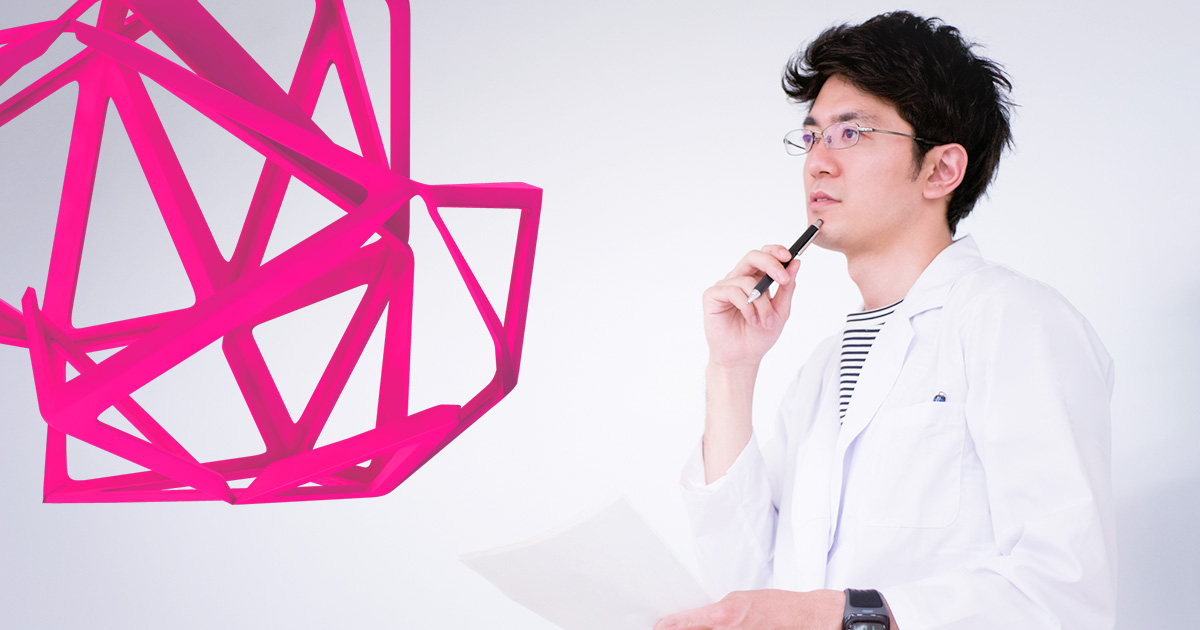<インタビュー>山口太郎-医学領域への恩返しのためのキャリアチェンジ
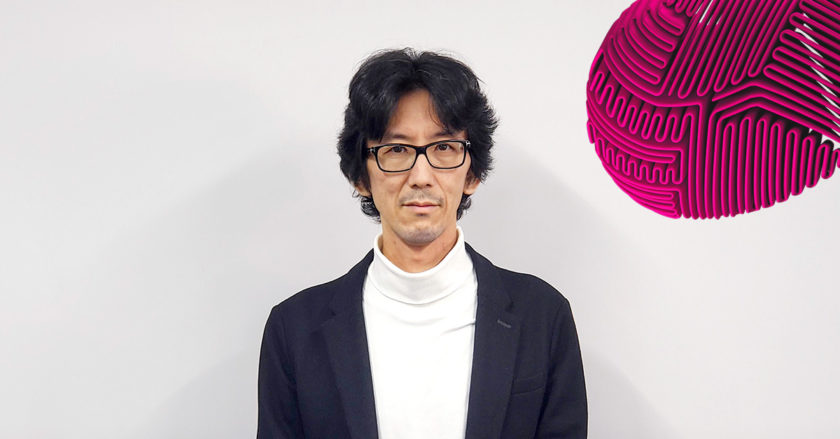
京都大学大学院医学研究科「医療領域」産学連携機構(KUMBL)の特定講師である山口太郎先生は、工学部出身で電機メーカーの知財部門に所属した経験を持ちながら、現在は京都大学の医学領域の研究成果を事業化するための部門に身を置きつつ、起業家育成支援を行っています。これまでのキャリアや現在の職務内容についてお話を伺いました。
>Click here for English version
闘病生活を経てのキャリアチェンジ
-これまでのキャリアを教えてください。
大学では工学部応用物理学科に入り、そのまま大学院の博士前期課程に進学しました。当時の研究テーマは、統計処理を用いた画像解析でした。
修了後は民間の電機メーカーに就職し、研究以外のことをやりたくて知的財産(知財)を扱う部門で勤務していました。その間に経営大学院にも通い、マーケティングなどを学んで経営学の修士号を取得しました。
その後、退職してから京都大学大学院医学研究科社会健康医学系専攻に入学して修士号を取得し、京都大学産官学連携本部での勤務を経て、現在のKUMBLでの仕事に至ります。
-民間企業を退職して大学院に入り直したのはなぜですか?
実は小学2年生のときに難病を発症して入院した経験があるのです。治療法はいまだにないものの進行が穏やかだったので就職するまで元気に過ごせましたが、徐々に病状が悪化して2年間休職を余儀なくされました。
復職したものの、今の仕事は自分がやりたいことなのか、やっていていいのかと悩んでいたのと、休職時にいろいろな方に支えていただいたので、恩返しというとおこがましいのですが医学領域で何か仕事ができないかと考えました。
ただ、すでに30歳を超えていたので、医学部に入り直して6年間大学に通うのはハードルが高く、かといって製薬会社への転職も現実的ではありませんでした。
-どうされたのですか?
大学院に入り直したほうが医学領域へのキャリアチェンジがしやすいのではないかと考え、いろいろ探していた中で、京都大学大学院医学研究科社会健康医学系専攻を見つけました。この専攻の中に知的財産経営学分野というものがあり、医学領域の研究成果を事業化していく上で必要な知財等のマネジメントなどが担える人材を育成するところです。
企業で知財を扱っていたこと、経営学の修士号を持っていること、また工学部出身でもあるので、文系と理系の両方のバックグラウンドを持っていて、プラス自分の闘病経験も活かせると考えて、退職して大学院に入り直しました。
-キャリアチェンジは大変だと思います。
生物学の実験をしたことがないままでの医学領域へのキャリアチェンジなので、余計に大変です。
知的財産経営学分野を終えた後、ちょうど京都大学が文部科学省の2年間の事業に採択されたタイミングでしたので、その事業担当として京都大学で働くことになりました。その間に病状がまた悪化して、最後の3ヶ月は入退院を繰り返すような状況でした。今思えばばかな話ですが、当時はキャリアのことを考えると病気のことを上司に言えず、最悪な状態でしたね。
プログラムが終わって、そこからまた2年半は闘病生活でした。回復した折に、上司だった寺西先生にご挨拶に伺った後ですが、またまたちょうど医学研究科で文科省の新しい事業がスタートするタイミングで雇っていただき今に至っています。
また現在、京都大学大学院経済学研究科の博士後期課程にも在籍しています。研究テーマは私の仕事内容にも関係するもので、インキュベーター、アクセラレーターがバイオ系ベンチャー企業の成長にどう貢献できるか、というものです。
イノベーションハブ京都の支援
-現在在籍しているKUMBLとはどのような組織ですか?
京都大学の医学領域から生まれた研究成果の事業化支援を行っています。医学領域なので、必ずしも医学研究科である必要はなく、薬学や工学(医療機器など)も範囲内です。その中でも、私の担当は医療機器です。医療機器と言っても幅広く、福祉用具やデジタルヘルスなども含まれます。
また、2017年に京都大学内で開所したイノベーションハブ京都の運営も担当しております。
-イノベーションハブ京都について教えてください。
医療ヘルスケアベンチャーの創出・支援を行う施設です。施設自体は医薬系総合研究棟という名称で地下2階、地上5階建てなのですが、その3階と4階をイノベーションハブ京都と名付けて運営しています。
-ここならではの特徴は何ですか?
ベンチャー企業の成長ステージに合わせたラボを用意しています。
一番簡単に借りられる部屋として「スタートアップオフィス」があります。入居企業にはフリーアドレスのデスクを1つ貸し出します。賃料は月額1万円で登記場所として使えるので、住所に「京都大学」が入ることで信用力の強化にもなります。
ある程度の資金が調達できたタイミングで入っていただくのが、「インキュベーション コア・ラボ」です。いわゆるシェアラボで、ベンチとデスクを1つずつお貸しします。ここではPoC(Proof of Concept、概念実証)を目指していただくことになります。
その後、ベンチャーキャピタルなどからまとまった資金が手に入ったら、一室丸ごと借りられる「アントレプレナー・ラボ」に入居して、じっくり研究開発を続けていただきます。
この3つがベンチャー企業向けの部屋です。他に、ベンチャー企業や京大の研究室とコラボしたいと考えている大企業向けに「アライアンス・ラボ」もあります。
-バイオ系のベンチャー企業では実験機器をそろえるのも大きな負担です。そのあたりのサポートはどうなっているのでしょうか?
各ラボはバイオセーフティレベルP2の実験が可能で、インキュベーション コア・ラボや3階と5階の医学研究支援センターには遠心分離機、フリーザー、クリーンベンチ、位相差顕微鏡、PCR装置など、一通りの実験機器があり、入居者であれば自由に使っていただけます。また、地下には動物実験施設も完備しています。
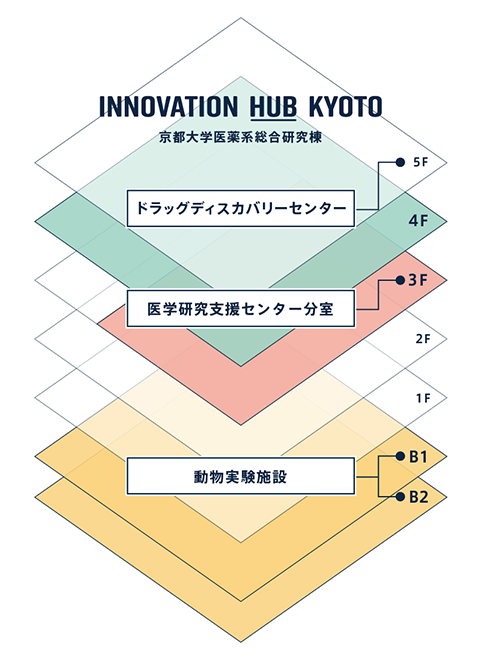
-入居状況はいかがですか?
スタートアップオフィスとアントレプレナー・ラボには二十数社にご入居いただき、おかげさまで満室の状況です。しかしながらインキュベーション コア・ラボはまだ少ないですね。日々の交流から新しい研究のヒントが生まれることを期待して、弊所としてはもっと活用してほしいと考えているのですが、同じ部屋の中で違う企業が隣同士というのは知財のことなどを心配されるようです。
-でも、その中からコラボしていいものができるとよいですね。
アメリカ・ボストンにあるLabCentralと同じ仕組みで、以前LabCentralの方が弊所を見学したときに、「最初はボストンでもシェアラボという形態がなかなか受け入れられず、今のようにうまく回るまで時間がかかった」と言っていました。イノベーションハブ京都は開所してまだ2年なので、コア・ラボのメリットを継続発信していけば、徐々に増えていくのではないかな、と考えています。
-他にはどのようなサポートがありますか?
イノベーションの創出には交流が重要なので、ほぼ毎月ミートアップイベントを開催しています。知財やファンディングなど内容は様々です。企業によるワークショップもやりますね。
医療ヘルスケア・イノベーション起業家人材育成プログラム(HiDEP)
-山口さんは「医療ヘルスケア・イノベーション起業家人材育成プログラム(HiDEP)」も担当されているとのことですが、これは何でしょうか?
①医療ヘルスケア領域における起業家人材の育成、②新規医療ヘルスケア機器・サービスの創出、③臨床現場起点の医療イノベーション創出エコシステムの構築、を目的としたプログラムです。これもイノベーションハブ京都に絡んだ取り組みで、ベンチャー企業の方々の入居を待つだけでなく、自分たちで作り上げて行こういう試みです。
-具体的にはどのようなカリキュラムになっていますか?
講義と実践に分かれており、前半の講義では医学や経営について学んでいただき、その後は京大病院や市中病院、高齢者福祉施設などの臨床現場を観察してヒアリングを行い、ニーズを掘り起こします。医療機器やサービスは医師や患者等が使うものなので、臨床現場のニーズ把握は必要不可欠です。ニーズを起点にソリューションを検討し、最終日にはベンチャーキャピタリストや医療関係の起業家といった専門家が各チームのビジネスアイデアを審査します。さらにポテンシャルの高いものについては私どもの組織が支援して、起業や製品の上市に結びつけます。
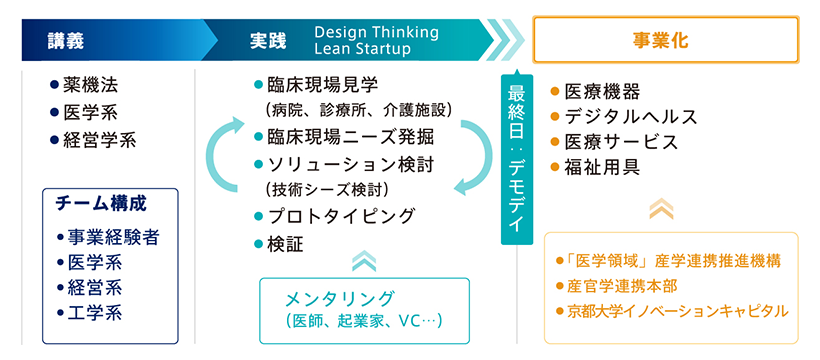
-どのような方が参加しているのですか?
大学院生や研究者だけでなく企業の方も参加しており、そのバックグラウンドは医学系、工学系、経営系と多様です。多種多様なバックグラウンドをお持ちの方たちでチームアップします。3年目の今年度から公募という形式にしたのですが、定員16名に対して30名以上の応募がありました。優勝チームには海外研修を予定しており、今年度はドバイで開催される国際展示会「Arab Health 2020」に招待します。
-それはすごいですね!
ちょっとやりすぎたかな、とも思っていますが(笑)。
今年度から5年間、AMED「次世代医療機器連携拠点整備等事業」(テーマ「医療・福祉等ニーズ起点で次世代医療機器開発を担える起業家精神を持つ人材の育成拠点」)に採択されましたので、臨床現場見学や医療従事者によるコンサルテーションなどは、さらに充実したものにしていきます。これまで臨床見学は、医療機器開発に興味のある一部の先生に頼っていたので見学できる診療科が限られていたのですが、今後は全診療科を見学対象にできるよう体制を整える予定です。
深い専門領域がありつつ幅広い領域を見る姿勢を
-今後、イノベーションハブ京都をどうしていこうとお考えですか?
開所して2年が経ちますが、入居したい企業の数が増えてきた一方でスペースの不足といった問題が出てきました。また、弊所は入居期限が5年なので、そろそろ企業の退去への対応も考える段階に来ていると思います。一施設のみではリソースに限りがありますので、他のインキュベーション施設と連携して、リソースを補完し合うことが必要になるのかもしれません。
さらに、当初弊所のソフト支援として、経営や法律のことも含めてメンターのような役割を想定していたのですが、最近はベンチャー企業の方でベンチャーキャピタルなどを通してそのような専門家を見つけていることが多いので、弊所から何が提供できるのか、改めて考え直しているところです。
-アカデミアと企業と両方経験されて、今はベンチャー企業の育成に関わっている山口先生から見て、研究者に求めてほしいことはありますか?
よく言われていることですが、今日では専門領域がかなり細分化されてきていて、そこを極めるだけではなかなかイノベーションを創出できにくくなっています。ですので、研究室にこもってばかりいないで、外に出ていろいろな領域の方々と接点を持つことが必要だと思います。それは研究者同士だけでなく、企業の方も含めて、です。ベースとして専門領域について深い知見・経験を持ちつつ、それ以外の幅広い領域について積極的に知ろうとする姿勢があるとよいと思います。
-最後に、山口先生ご自身の今後について教えてください。
正直なところ、病気のことがあるので5年先、10年先の未来がどうなるかわかりません。ですので、先のことをあれこれ考えるというよりは、今やれることを一生懸命にやる、と言ったところでしょうか。
実は、医学研究科の教員、経済学研究科博士後期過程の学生に加え、2019年11月から、京都大学発ベンチャーの(株)ナールスコーポレーションで産学連携フェローとして仕事をすることになりました。これら3つの役割を全うできるよう励んでいきたいと思います。
-新しいものが好きなのですね。
うーん、飽き性なので(笑)、新しいことに取り組むのは好きかもしれません。常に新しい刺激がほしいです。そういう意味ではベンチャー企業の創出・支援に関わる、今の仕事は合っているのかな、と思います。
<プロフィール>
山口太郎(やまぐちたろう)
京都大学大学院医学研究科 「医学領域」産学連携推進機構 特定講師
シャープ(株)知的財産権本部、京都大学産官学連携本部を経て、2014年より現職。現在は主に、医療機器案件、医療ヘルスケア起業家育成プログラム「HiDEP」の企画・運営、インキュベーション施設「Innovation Hub Kyoto」の運営を担当。また2019年より京大発ベンチャー「ナールスコーポレーション」の産学連携フェローを兼務。大阪大学工学部応用物理学科卒業。工学修士(大阪大学)。経営学修士(神戸大学)。社会健康医学修士(京都大学)。2019年より京都大学大学院経済学研究科博士後期課程在籍。
Taro Yamaguchi is a Senior Lecturer at the Kyoto University Medical Science and Business Liaison Organization (KUMBL). He holds a degree in Engineering and previously worked in the intellectual property division of an electronic manufacturing company before transitioning to his current position at Kyoto University. In his position, he facilitates commercialization of research outcomes in the medical science field and supports the growth of entrepreneurship. We asked him about his career path and his current role.
Changing your career path while battling a disease
-Tell us about your career path.
I majored in applied physics during my undergraduate studies, and went on to complete a Master’s degree in the Department of Engineering. In graduate school, I researched image processing using statistical methods.
After completing my Master’s degree, I started working in an electronic manufacturing company. As I wanted to do something different from research, I worked within a division that dealt with intellectual properties. At the same time, I went to a business school and learned about the different aspects of business, such as marketing, and earned my MBA degree.
I then left my job and entered Kyoto University School of Public Health, where I completed my Master’s degree. I worked in the Office of Society of Academia Collaboration for Innovation (SACI) before transitioning to my current role at KUMBL.
-Why did you leave your industry position to go back to graduate school?
I developed an intractable disease and had to be hospitalized when I was in grade 2. There is currently no treatment available for this disease, but I was able to live without any major issues because my disease progression was relatively slow. Unfortunately, my condition deteriorated when I started working and I had to take the time off from work for 2 years.
After going back to my position in the company, I was unsure of whether I was doing what I really wanted to do, and whether the job was truly something for me. I also wanted to give back to the medical community because I received tremendous support from many people while I was away from work.
I was over the age of 30 at this point, and I figured that it would be difficult to go back to medical school and study for 6 years. Working at a pharmaceutical company was not a realistic option for me either.
-So what did you do?
I thought that going back to graduate school was the closest pathway for me to enter the field of medicine. I was looking for options and found the Kyoto University School of Public Health. Within the school, the Department of Management of Technology and Intellectual Property was focused on educating future managers of intellectual property to promote technology transfer in the field of medicine. As I had a background in engineering and an MBA, as well as an experience in the field of intellectual property management, I thought this was a great fit for me to grow while building upon my background in business and science. I also saw this as the perfect place to share my experience with my disease, which is why I left my job and went back to school.
-It must have been challenging to change your career completely.
Yes, especially because I went into the medical field without having any experience in biological experiments.
When I completed my studies in intellectual property management, Kyoto University was just about to embark on a 2-year program funded by the Ministry of Education, Culture, Sports, Science and Technology. I was hired by the University to work on this program, but my condition worsened and I had to be hospitalized multiple times during the last 3 months. It sounds silly now, but I was not able to tell my boss about my disease because I was worried about my career and job security. This was a pretty bad situation now that I think back.
When the program was completed, I had to focus on my disease again for 2.5 years. After my recovery, I went back to see my former manager, Dr. Teranishi. Luckily, as the School of Public Health was just about to start a new program funded by the Ministry, I was hired again by the University and that is where I am now.
Currently, I am also enrolled in the Graduate School of Economics to complete my PhD degree. My research theme is highly relevant to my current position, and focuses on how incubators and accelerators can aid in the growth of biomedical start-up companies.
Managing the Innovation Hub Kyoto
-Please tell us about the Kyoto University Medical Science and Business Liaison Organization (KUMBL).
KUMBL supports the commercialization of medical science research outcomes generated from Kyoto University. It is not restricted to research within the Department of Medicine as it encompasses any type of research from the medical science field. This may include anything from pharmaceutical sciences to engineering such as medical devices. Specifically, I am in charge of the medical devices section. Medical devices that we deal with vary widely, and include assistive technologies and digital health devices.
I also manage the Innovation Hub Kyoto, which opened its doors in 2017 at Kyoto University.
-Please tell us about the Innovation Hub Kyoto.
The primary goal of the organization is to establish and nurture the development of medical and healthcare start-up companies. We are housed within the Med-Pharm Collaboration Building, which has a total of 7 floors with 2 basement levels. The Hub is located on the 3rd and 4th floors.
-What is unique about the Innovation Hub Kyoto?
The Hub is equipped with laboratory space that meet the needs of start-up companies at different stages of growth.
In the early stage of growth, researchers can rent what we call “start-up offices”, which are desk spaces with a free business address. The monthly rental fee is 10,000 yen. They can use the address to register their business, and there is certainly value to having Kyoto University in the address.
After obtaining some level of funding, researchers can then occupy a space within the “Incubation Core-Lab”. It is a shared laboratory space where researchers can rent a bench and a desk. In this space, researchers can perform proof-of-concept studies.
They can rent an entire room within the “Entrepreneur Lab” when they have secured sufficient funding from investors such as venture capitals. This is a space where they can continue their R&D activities for further growth of their companies.
The three types of spaces are available to start-up companies. We also have what we call an “Alliance Lab”, where large companies can foster collaboration with other start-up companies and laboratories within Kyoto University.
-There is a tremendous cost associated with equipment and infrastructures needed for start-up companies in the biomedical field. How does the Innovation Hub help support them?
Each laboratory complies with Biosafety level P2. The Incubation Core-Lab and Medical Research Support Center on the 3rd and 5th floors are equipped with many instruments, including centrifuges, freezers, clean benches, phase-contrast microscopes, and PCR systems. All occupants of the Hub have access to these instruments. We also have an animal facility in the basement.
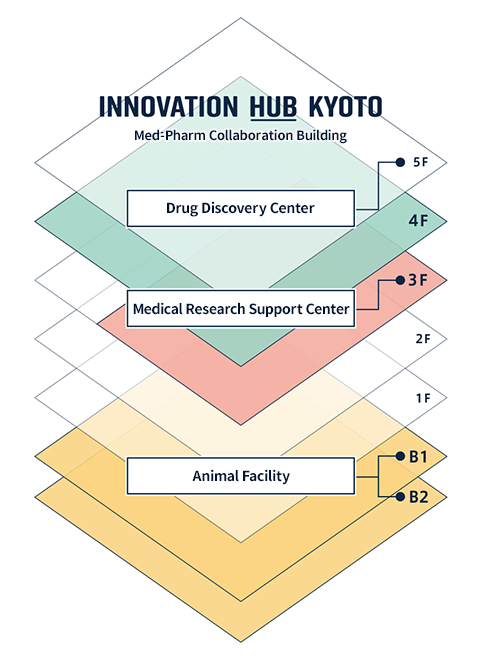
-What is the occupancy status of the space?
The Start-up Offices and Entrepreneur Lab are fully occupied with over 20 companies, but we still have some space available within the Incubation Core-Lab. Although we think that the space can help researchers come up with new ideas through knowledge exchange, researchers often worry about intellectual property because the Lab is designed for different companies to share the same space.
-But this space can also foster collaborations.
Definitely. Our space is designed in a similar manner to LabCentral in Boston, United States. When the representatives from LabCentral came to visit our space, they mentioned that it took some time for them to become what they are now because the concept of shared laboratory space was not well-accepted in the beginning. As the Innovation Hub Kyoto opened its doors 2 years ago, we anticipate that the number of occupants in the Core-Lab will increase gradually by continuing to announce the merit of it.
-What other types of support are available to researchers?
Knowledge exchange is core to innovation. We hold meet-up events almost every month and discuss a variety of topics, including intellectual property and funding. We also host companies to hold workshops.
Healthcare Innovation Design Entrepreneurship Program (HiDEP)
-You also manage the “Healthcare Innovation Design Entrepreneurship Program (HiDEP)”. Tell us about this Program.
The program is aimed to 1) help the growth of entrepreneurs in healthcare fields, 2) promote the development of novel medical devices and healthcare services, and 3) establish an ecosystem of healthcare innovation based on the clinical needs. This program stemmed from the Innovation Hub Kyoto, and gives us the opportunity to take the initiative rather than simply waiting for start-up companies to occupy our space.
-What does the curriculum look like?
The courses are divided into lectures and hands-on workshops. In the first half of the program, participants will have the opportunity to learn about medicine and business management through a series of lectures. In the last half, participants will visit different clinical settings, including the Kyoto University Hospital, and local hospitals and long-term care facilities, to identify needs. This is essential as the design of medical devices and services must keep in mind the end-users such as physicians and patients. We have the participants form teams and discuss solutions based upon unmet needs, and invite specialists, such as venture capitalists and entrepreneurs, in the healthcare fields on the last day of the program to evaluate the proposals of each team. We support the idea with the highest potential for success by facilitating the processes towards its commercialization.
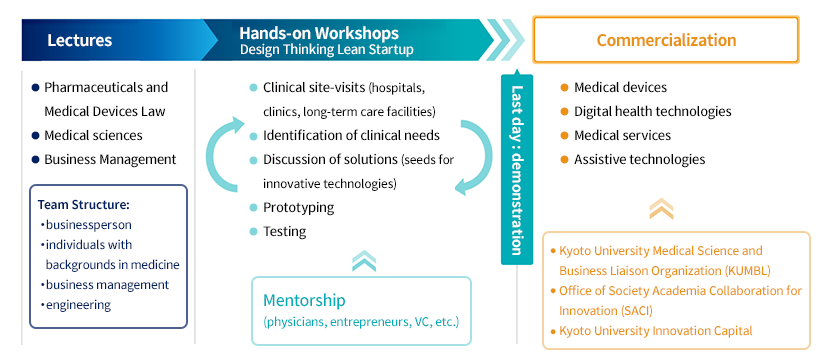
-Who are the participants of the program?
We have graduate students and researchers, as well as individuals from the industry. They come from a wide variety of backgrounds, including medicine, engineering, and business management, and those with different backgrounds are teamed up together. This year was the third year since the start of the program and we had an open call for participants for the first time. We had 30 applicants for 16 available spots. We provide the winning team with an opportunity for training abroad, and this year we will bring the winners to an international conference called “Arab Health 2020” that will be held in Dubai.
-That sounds amazing.
Yes, we may have taken it too far this year!
We are excited to expand our program with additional funding we obtained from AMED “Project to Promote Collaboration for the Development of Next-generation Medical Devices” for our 5-year project entitled “Cultivating entrepreneurial talents for the development of next-generation medical devices based on unmet needs in healthcare”. The funding will enable us to enrich the program by adding more visits to clinical sites and inviting healthcare professionals as consultants. Previously, site visits relied on physicians who were interested in medical device development, and were therefore limited to certain departments within hospitals. We hope to change this by expanding these site visits across all clinical departments.
Seeing the bigger picture while developing in-depth knowledge
-How do you plan to grow the Innovation Hub Kyoto?
It has been two years since we first opened its doors. As we see an increasing number of companies that are interested in being part of the Hub, we are also becoming aware that we have limited space available to accommodate them. Companies are only to be with us for the maximum of 5 years, and we are expecting some of them to leave and move forward to their next steps. As our resources are limited, we may need to work with other incubation facilities to share additional resources.
We initially positioned ourselves as mentors to researchers to teach soft skills, including business management and law, but we found that start-up companies are able to find themselves those specialists through venture capital firms. Now, we are reconsidering what unique opportunities we can provide to researchers.
-You have experience in both academia and industry, and are now involved in promoting the growth of start-up companies. From your perspective, what would you encourage researchers to do?
In the recent era of medical research, fields are divided into numerous subspecialties and researchers are finding themselves in a narrow niche. I find that this makes it difficult to innovate. I think it is important to get out of the lab and connect with others in different fields, including both researchers and individuals from the industry. Researchers should have in-depth knowledge and experience in their own fields, but I also think it is important for them to be open-minded and take the initiative to learn about other fields.
-Lastly, tell us about your plans for the future.
I am not sure what my future will be in 5 or 10 years because of my disease. I try to focus on my current tasks and strive to do my best rather than worry about what may happen in the future.
In addition to my current position as a Lecturer in the Graduate School of Medicine and as a PhD student in the Graduate School of Economics, I will start my industry fellowship in November 2019. This fellowship will be completed at the NAHLS Corporation, which is a start-up company launched by Kyoto University. I will try my best to fulfill my roles in these three positions.
-It seems like you look for new challenges.
I tend to get bored easily and I do like to try new things. I always look for something new and interesting. In that sense, I think my current role suits me because I am able to be involved in the growth of start-up companies.
Profile:
Yamaguchi Taro
Senior Lecturer at the Kyoto University Medical Science and Business Liaison Organization since 2014.
Mr. Yamaguchi has previously worked in the intellectual property division at Sharp Corporation and the Office of Society Academia Collaboration for Innovation at Kyoto University. In his current role, he manages projects in medical device development, coordinates the Healthcare Innovation Design Entrepreneurship Program (HiDEP), and runs the incubation facility called the Innovation Hub Kyoto. He is also completing an industry fellowship at NAHLS Corporation, which is a start-up company launched by Kyoto University. He graduated with a B.Eng. in Applied Physics from Osaka University. Subsequently, he obtained an M.Eng. from Osaka University, MBA from Kobe University, and M.Sc. in Public Health from Kyoto University. In 2019, he enrolled in a PhD program at the Kyoto University Graduate School of Economics.

下記フォームでは、M-hub(エムハブ)に対してのご意見、今後読んでみたい記事等のご要望を受け付けています。
メルクの各種キャンペーン、製品サポート、ご注文等に関するお問い合わせは下記リンク先にてお願いします。
*入力必須

